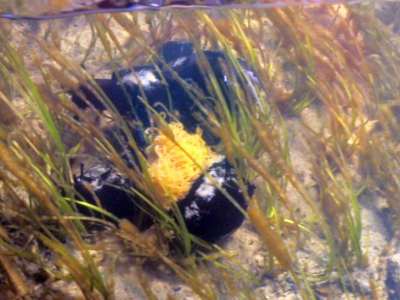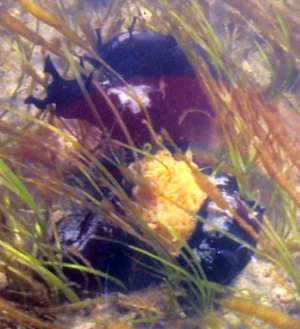Aplysia juliana - breeding in Tasmania
November 16, 2003
From: Melanie Godfrey-Smith

Hi there. Please pass this on to anyone who may be interested.
In the last three weeks, seemingly from nowhere, we have many hundred thousand of these at Henderson Lagoon, Falmouth, Tasmania [Australia]. Previously Asterias amurensis and also Carcinus maenas have been studied in this lagoon as well.
They are solid coloured and appear to be black, but could be dark brown. Very few have 2 or 3 small white or grey/white stripes. There are hundreds of thousands and they "carpet" the lagoon for kilometres in all directions from the middle. Within the last 4 days they have started "nesting" (if that is the right word) and about 20% seem to be producing eggs. (per photos) Some appear to be dying this week, and many are reaching the estuary and floating out to sea on the tide, but there are many, many thousands still here.
I chose the worst possible day to try to capture an image and will endeavor to get a better image tomorrow or the next day.
I hope this is of interest.
Melanie Godfrey-Smith
falmouth@bigpond.com


Dear Melanie,
You can rest easy. This is not another northern hemisphere invader like the unwelcome crab [Carcinus maenas] and starfish [Asterias amurensis] you mention. Sea Hares often suddenly seem to appear like this from nowhere in huge numbers to breed and die. Their appearance can cause locals, such as you, to worry about foreign invaders and their deaths can cause others to worry about pollution. Have a look at the page on Mass Mortality for futher information on this topic.
I am pretty sure your animal is Aplysia juliana. It often occurs in large breeding aggregations like this in early spring, but not always in the same locality. In Sydney it usually occurs a couple of months earlier - say September - but by chance I got an inquiry yesterday from someone who had just seen large numbers laying eggs in the Parramatta River, the large estuarine extension of Sydney Harbour.
Best wishes
Bill Rudman
Related messages
-
Sea hares from Tristan da Cunha
From: Sue Scott, June 1, 2010 -
Aplysia juliana? from Reunion Island
From: Philibert Bidgrain, January 31, 2007 -
Re: Aplysia juliana in my aquarium
From: Michelle Yerman, May 25, 2006 -
Aplysia juliana in my aquarium
From: Michelle Yerman, May 19, 2006 -
Aplysia juliana eaten by Flatworm
From: Lisa Kirkendale, April 10, 2006 -
Re: Sea Hares laying noodle shaped things in tank
From: Marcus van Riet, December 17, 2005 -
Sea Hares laying noodle shaped things in tank
From: Marcus van Riet, December 6, 2005 -
Aplysia juliana? in Kiama rock pools, NSW
From: Francis Hawkshaw, August 9, 2005 -
Aplysia juliana being eaten by crab
From: Dong Bum Koh, June 7, 2005 -
Aplysia juliana laying eggs
From: Dong Bum Koh, May 25, 2005 -
Aplysia juliana - breeding in NZ
From: Paul Furneaux, August 16, 2003 -
Aplysia juliana from New Zealand
From: Paul Furneaux, June 30, 2003 -
Sea hares, mating pair - from Sydney
From: Iain Whyte, November 30, 2002 -
Aplysia juliana from Korea
From: Ronald Noseworthy, June 19, 2002 -
Re: Aplysia from Taiwan
From: Tony Wright, April 16, 2001 -
Aplysia from Taiwan
From: Tony Wright, April 14, 2001 -
Sea Slug feeding and babies
From: Andrew McDonald, February 16, 2000
